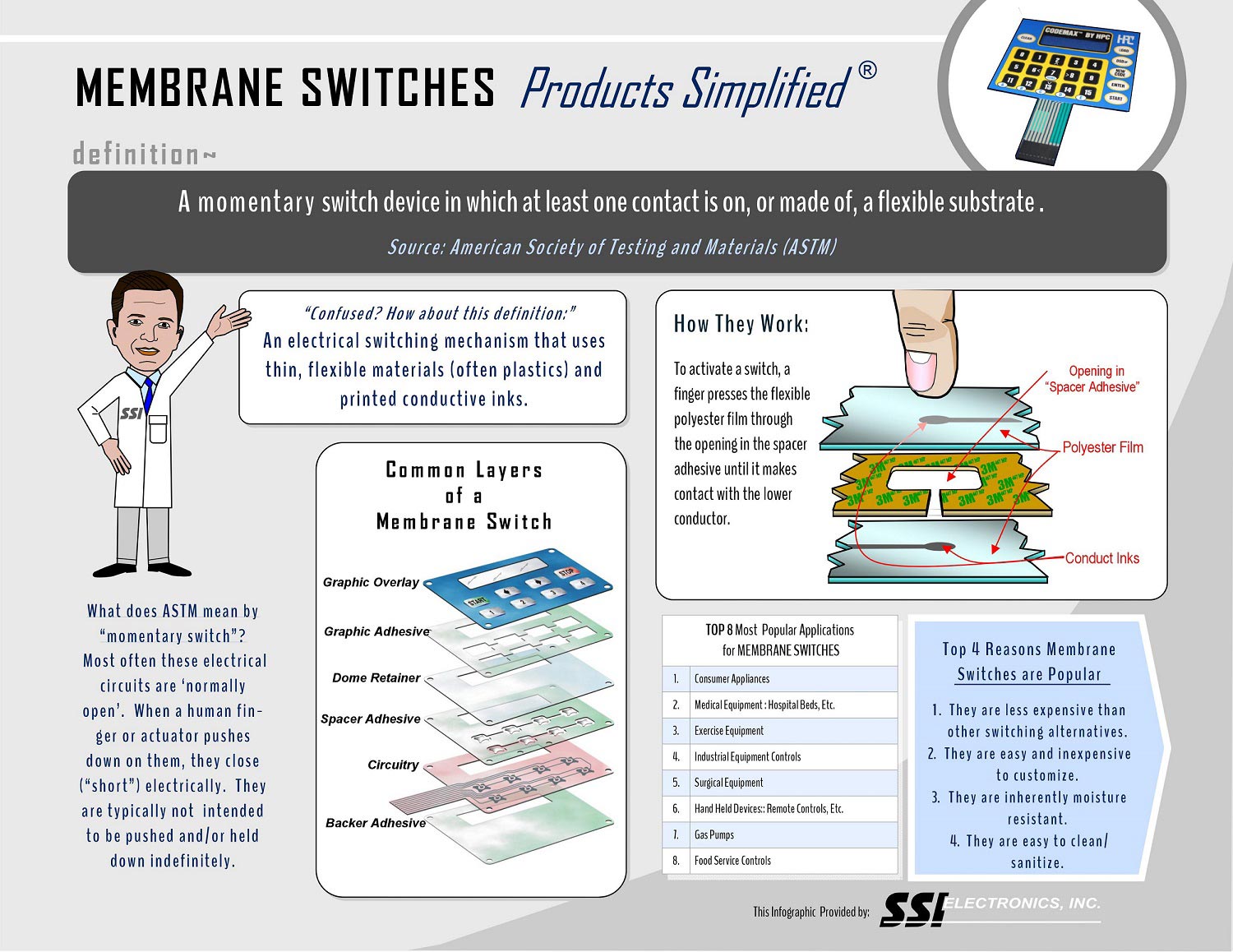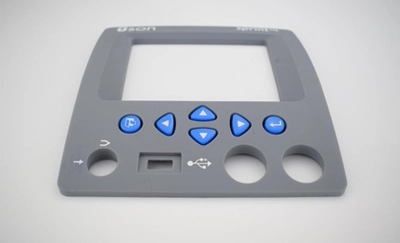Comprehending the Significance of Membrane Switch Over in Modern Electronics
Membrane layer buttons are essential elements in contemporary electronic tools. They supply a blend of performance and style that boosts customer interaction. Their long lasting and light-weight nature makes them appropriate for different applications. As sectors evolve, the need for customization and progressed functions grows. Recognizing exactly how membrane switches over add to technology reveals their significance fit the future of electronics. What exists ahead for this innovation?
The Fundamentals of Membrane Layer Switch Technology
Although typically overlooked, membrane layer button innovation plays an important role in the modern electronics landscape - membrane switch. These gadgets, composed of numerous layers, offer as user interfaces for different digital items, ranging from house home appliances to clinical tools. A normal membrane switch includes a graphic overlay, a spacer layer, and a circuit layer, which are carefully constructed to develop a functional interface.When pressure is related to the overlay, the circuit layer is completed, permitting signals to be transmitted to the gadget. This innovation is recognized for its versatility, making it possible for customization in design, capability, and form to satisfy specific customer demands. In addition, membrane buttons are thin and lightweight, making them suitable for applications where area is a costs. Their longevity and resistance to ecological elements additionally enhance their charm, ensuring they can withstand rough problems while maintaining capability. Generally, membrane button innovation is integral to developing reliable and easy to use digital gadgets

Key Benefits of Membrane Layer Switches
Membrane switches offer numerous crucial benefits that make them a recommended choice in numerous electronic applications. Their layout permits a portable kind aspect, allowing makers to produce lightweight and smooth devices. Additionally, membrane layer buttons are immune to dust, dampness, and chemicals, which enhances their resilience and long life sought after environments. The responsive comments supplied by these buttons can improve individual experience, making them very easy and user-friendly to operate.Furthermore, membrane buttons can be customized with diverse graphics and colors, permitting special branding possibilities. The production procedure is typically cost-efficient, especially for high-volume manufacturing, as it decreases assembly time and simplifies style. Membrane layer switches need minimal maintenance, contributing to reduced overall operational expenses. These advantages underscore their expanding popularity in modern electronic devices, where dependability and user-friendly user interfaces are crucial.

Applications Throughout Various Industries
The adaptability of membrane layer switches enables their widespread fostering across numerous sectors. In the clinical area, they are frequently used in analysis equipment and patient tracking systems, using a sturdy user interface immune to impurities. The automotive market utilizes membrane switches for dashboard controls, boosting customer experience with sleek designs that endure severe problems. In customer electronics, they act as control panels for tools such as microwaves and coffee machine, offering an user-friendly user interface that is easy to tidy. The aerospace industry employs membrane switches in cockpit controls, where integrity and space effectiveness are critical. In addition, the commercial field leverages these switches in machinery and control systems to assure durable operation in demanding atmospheres. This wide range of applications underscores the adaptability of membrane buttons, making them important components in enhancing capability and customer interaction throughout diverse technical landscapes.
Personalization and Design Flexibility

Future Fads in Membrane Switch Growth
Arising trends in membrane switch growth indicate a growing focus on boosted capability my blog and combination with clever modern technologies. As consumer demand for extra sophisticated electronic devices boosts, producers are focusing on creating membrane switches over that not just serve standard operational roles yet additionally integrate features like touch sensitivity, backlighting, and haptic feedback.Furthermore, improvements in products are expected to improve toughness and environmental resistance, making membrane switches over appropriate for diverse applications in sectors such as healthcare, automobile, and consumer electronics. The combination of capacitive touch technology is likely to come to be more widespread, enabling sleeker designs and enhanced customer interfaces. membrane switch.Additionally, the rise of the Internet of Things (IoT) is motivating the growth of membrane layer switches that can communicate wirelessly with various other devices, improving interconnectivity. On the whole, the future of membrane button modern technology appears appealing, driven by advancement and the pursuit of user-friendly options
Regularly Asked Inquiries
How Do Membrane Layer Switches Contrast to Traditional Mechanical Switches?
Membrane buttons, being a lot more space-efficient and using a smooth design, comparison with standard mechanical switches that offer tactile responses. The previous typically feature customizable graphics, while the latter usually ensure longevity and reliability in numerous applications.
What Products Are Typically Utilized in Membrane Layer Switch Production?
Membrane buttons are typically generated making use of materials such as polyester, polycarbonate, and published conductive inks. These products offer resilience, versatility, and responsiveness, making them ideal for different applications in digital tools and individual interfaces.
Can Membrane Layer Switches Be Fixed or Recycled?
Membrane layer switches can commonly be repaired, especially if small problems emerge, such as adhesive failing or surface damage. Nonetheless, complete reuse is normally restricted due to wear and potential destruction of materials with time.
Exactly How Do Ecological Elements Influence Membrane Layer Switch Over Efficiency?
Environmental variables, such as exposure, temperature level, and humidity to chemicals, greatly affect membrane layer button efficiency. Extreme problems can lead to destruction, influencing responsiveness and long life, eventually endangering the performance of the device in numerous applications.
What Is the Normal Life-span of a Membrane Switch?
The regular life-span of a membrane layer switch generally varies from 1 to 5 million actuations, depending on factors such as use regularity, ecological problems, and the products used in production, affecting durability and performance durability. A typical membrane button consists of a visuals overlay, a spacer layer, and a circuit layer, which are thoroughly set up to create a functional interface - membrane switch.When pressure is applied to the overlay, the circuit layer is completed, permitting signals to be transmitted to the gadget. The tactile responses supplied by these switches can enhance individual experience, making them very easy and instinctive to operate.Furthermore, membrane switches can be personalized with varied graphics and shades, allowing for distinct branding chances. As customer demand for more sophisticated digital tools rises, manufacturers are concentrating on developing membrane changes that not just serve fundamental operational roles but additionally integrate functions like touch level of sensitivity, backlighting, and haptic feedback.Furthermore, innovations in materials are anticipated to boost sturdiness and environmental resistance, making membrane changes suitable for diverse applications in industries such as health care, vehicle, and consumer electronic devices. The integration of capacitive touch technology is most likely to come to be a lot more prevalent, enabling for sleeker layouts and improved user interfaces.Additionally, the surge of the Web pop over to this site of Points (IoT) is motivating the browse around this site development of membrane switches over that can interact wirelessly with various other devices, improving interconnectivity. Membrane buttons, being much more space-efficient and providing a streamlined design, contrast with standard mechanical switches that give tactile responses